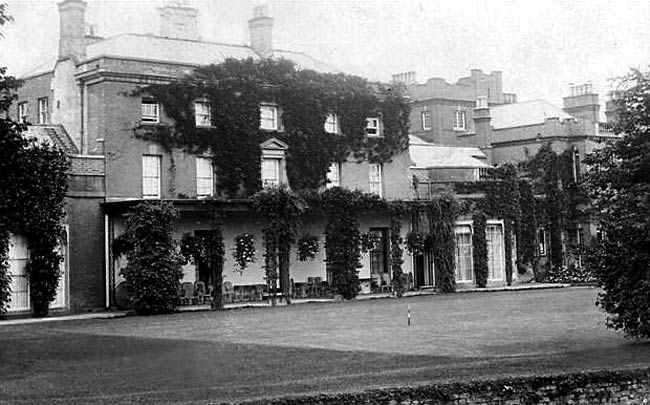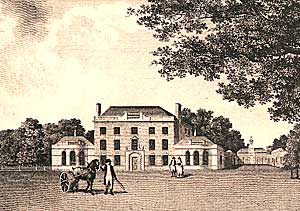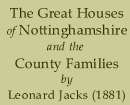< Winkburn | Contents | Wollaton >
Wiseton

Wiseton Hall in the early 20th century. The hall was built in 1771 and was demolished in 1960.
Photograph courtesy of Brenda Eastwood.
AT Wiseton Hall I met a worthy old man, not "myriad wrinkled," like the dumb servitor in Mr. Tennyson’s charming idyll, but keen-eyed, clear-visaged, and garrulous, who remembered the late Lord Althorpe, Chancellor of the Exchequer under the Administration of Lord Grey. Wiseton was for some generations the residence and property of the Ackloms, a family of some considerable consequence in the county, whose representatives took a pride in their estate, and spent much time in working improvements thereon. From them, it passed into the hands of Earl Spencer, who gave an Acklom heiress a title in exchange for her wealth. On the death of Lord Spencer, the estate was sold to Mr. Nevile, of Thorney ; then it became the residence of Mr. Robert Manners-Sutton, who, like his predecessor, was a clergyman, and, until lately, it was the residence of the late Mr. Robert Laycock, M.P., whose father, a wealthy north of England magnate, purchased it some fifteen years ago. Lord Althorpe spent at Wiseton much of the time that was not occupied within the cares and anxieties of office. It was isolated, quiet, and out of the reach of official despatches; not a sound to be heard but the music of wind-stirred leaves or the lowing of distant cattle. But the privacy of this Sabine retreat was constantly invaded by the disturbing influences of political life. Here at Wiseton the Minister would gather round him some of the chief officers of State, and time leading movement of the time—the Reform Bill—was discussed in that big dining room, where we lunched to-day. Lord Brougham was a constant visitor at Wiseton, and it is more than probable that Lord Melbourne, and Lord Palmerston himself, partook of the Nottinghamshire hospitality of the genial and cultivated holder of the national purse strings. At any rate, hither came the Lord Chancellor at this great epoch in the political history of the country, and it is more than likely that under this very roof, the outline of tIne first Reform Bill was conceived. Whenever Lord Brougham visited his estate in the north, he made a point of calling upon his distinguished colleague at Wiseton. Those were times of great excitement, and Lord Brougham, warmed with enthusiasm, would rise from the table, so my venerable informant told me he had heard, and strike his noble host on the shoulder when moved by any happy thought connected with the great and absorbing question of that day. The house was always full of company in those days. It was a pretty retreat, and its lord was a man of refined intellect and rare social qualities. Lord Exeter, the Duke of Bedford, Lord Tavistock, Lord Normanby, Lord Ducie, and a host of other notabilities at times made it their home.

Wiseton Hall, c.1790.
It may, perhaps, be taken as a characteristic of English life, that beautiful, as many of these country houses undoubtedly are, it is only during a few months of the year that they are occupied. If the head of the house has Parliamentary duties to attend to, it may he taken for granted that he only enjoys the sweet air which blows across his park for a very short time, and his fine house is left for many months to the care of servants. It is closed during the best part of the year, and the master is away when the rhododendrons are at their best, and when laburnumus are raining their showers of gold. The late Mr. Laycock did not spend much time at Wiseton, and he pleaded guilty to absenteeism, hut, he added, his absence was attributable to causes, different from those which operate upon Irish landlords. Indeed, he was popular enough amongst his tenants and neighbours, as he was amongst all who knew him. To the restoration at Clayworth Church, a work which was entrusted to Sir Gilbert Scott, the late Mr. Laycock contributed largely. He now lies buried within its quiet precincts. There are some fine stained-glass windows here, which Bishop Trollope has pronounced to be amongst the best in the county, and under the hand of the great architect, whose name I have mentioned, the building has been beautified, to an extent which has given it the deserved reputation of being one of the handsomest churches in the county. Through the stained-glass comes a subdued and mellow light, which falls upon a bright altar, covered with a handsome cloth, the gift of Mrs. Laycock. I merely mention Clayworth Church incidentally, but, as the family, residing at Wiseton Hall for the time being, must be considered, as in some manner, associated with the church, its appearance in this article cannot be considered out of place. And while here, one cannot avoid noticing the curious arches, which span one side of the aisle, and a very fine specimen of plaster-work, which appears in the form of a handsome tomb to certain of the Fitzwilliam family. A Roman road divides Wiseton Park from the farm lands, and makes a break in an admirable expanse of scenery, which is further diversified by the temperate course of the Chesterfield Canal, with its sedgy banks, and the most impetuous current of the river Idle, which makes its progress in graceful curves. On the estate are the few grey stones that are left of Mattersey Abbey, and half-a-dozen pleasant views, if one has time to enjoy them sufficiently. Mr. Laycock farmed some 400 acres of land on the best of principles, and, judging from the very prosperous and thriving condition of the horned occupants of a long range of stalls, he was a successful breeder of stock.
It may have been the genial qualities of Lord Spencer, and the amiable disposition of his lady, that brought so many distinguished persons to his lordship’s hospitable board. It may have been the beautiful situation of the house, with the amusements and diversions it afforded, that caused Wiseton in this out-of-the-way part of the world, to be a popular house of call. But whatever the attraction may have been, certain it is that Wiseton Hall was never dull, and it was generally full of company. There was the park to range in, there was the game to shoot, there were the pleasant gardens stocked with fine trees and shrubs, ranging in pretension from a magnificient specimen of the fern-leaved beech of most elegant proportions, to the humble laurel and bay ; there was the library with its choice collection of books, there was the social dinner table where politics were not excluded, and where the Reform Bill and the condition of the coverts were alike acceptable as questions of debate and controversy. The mansion has not materially altered since those days. The handsome paper which adorns the wall of the billiard room with a bright expanse of mural art, was brought by Lady Althorpe from Switzerland. The electioneering canard in the late Mr. Laycock’s room, representing Lord Spencer and two other distinguished political figures of that day, has caused many a hearty laugh, and the queer-looking vane, which marks the wind’s variation at the topmost part of the house, has been the subject of many a well-timed joke. This represents a favourite dog, to which Lord Spencer was so fondly attached, that when it died he had its exact shape cut out in tin, to be placed on the top of the house.
The dining room at Wiseton is a spacious apartment; square and roomy, and evidently designed to suit the taste of a man who appreciated the fitness of things. Four massive pillars give it a hall-like appearance ; its looks over the park, commands a pretty bit of pleasure garden, and is abundantly lighted. On its walls there are some old portraits, which were in the house when Mr. Laycock came to it. Two of them, of Sir Thomas and Lady Whichcote are attributing to Lely, and they certainly bear some of the distinguishing characteristics of that great artist; and there is another of Lord Eustace Cecil, a member of the Burleigh House family. The drawing room is almost as good a room as that in which the family take their principal meals ; indeed, they are two of the best rooms that are to be seen in the county. The drawing room is furnished with taste and elegance, and a vast and glittering chandelier of Venetian glass, which Mr. Laycock purchased in Venice during his travels, is not out of harmony with the character of the other furniture. Here, amongst articles of virtu, and a variety of pretty things, distributed about the room, are some pictures that one knows something about. There is a fine water-colour of a Scotch deer forest by T. M. Richardson, a careful and breezy study of a special type of Highland scenery: a water-colour sketch of the Forum, executed on commission for Mr. Laycock; an admirable pen and ink sketch, presenting all the firmness and truth of a modem engraving, by a local lady, representing a well-known scene in " The Two Gentlemen of Verona"; and a study of game, by Richardson, a friend of Mr. Laycock’s, whose paintings have found their way into many collections, from which indifferent work is carefully excluded. Among other works of art that ornament this beautiful room, is a splendid figure in bronze, bought in Rome, and representing Narcissus, who was over enamoured of his own water-reflected image. In the library there are plenty of books, plenty of luxurious seats, and a plentiful supply of agreeable light. Some of these books belonged to Lord Spencer, and are chiefly political treatises. Others have been added by Mr. Laycock, who made politics his special study. Mr. Laycock commenced life as a barrister, and went the Northern circuit. Like other sons of the wealthy, who do not adopt the legal profession for the sake of making a living, Mr. Laycock soon left the bar, and settled down as a country gentleman, turning his attention chiefly to politics. He tried to get into Parliament for North Notts., in 1872, but failed ; he tried for Nottingham at the general election of 1874, and failed a second time. But he was not the man to be downcast by defeat, and at the general election of 1880, he came forward at the eleventh hour to contest a division of an adjoining county. He pursued his canvass with an amount of pluck and zeal, not always manifested by county gentlemen of large fortune, and he turned out a man, whose family has long been connected with North Lincolnshire by territorial ties. Mr. Laycock was not a student though he did well at Trinity College ; but he was a shrewd, well-informed man, who was well up in those matters which ordinarily come under the notice of Parliament, and the interests of North Lincolnshire, to some extent, an agricultural constituency, did not suffer in his hands. A man of less ability, who had fought two hard and expensive battles for the Liberal party, would deserve to be rewarded and congratulated. After Mr. Laycock had obtained a seat in Parliament, he spent less time than ever at Wiseton. He attended assiduously to his Parliamentary duties, amid his death, in August, 1881, was a matter of regret, not only in the constituency which he so faithfully represented during the short time he was permitted to enjoy the honour he had won so well, but amongst a large circle of friends and acquaintances.
There are some good engravings in this cheerful library, and a very fine medallion of the late Lord Spencer, whose distinguished descendant, now holding the seals of office, has been lifted to his pony, when a boy, by that very fine example of the " oldest inhabitant" to whom attention was drawn at time commencement of this article. There is an admirable print of Lord Brougham, and a fine engraving of Salvator Rosa’s picture "St. John preaching in the wilderness." These I had an opportunity of looking at whilst my kind host was searching for a piece of information in a book, which he had reached from the well-stocked shelves of the library.
